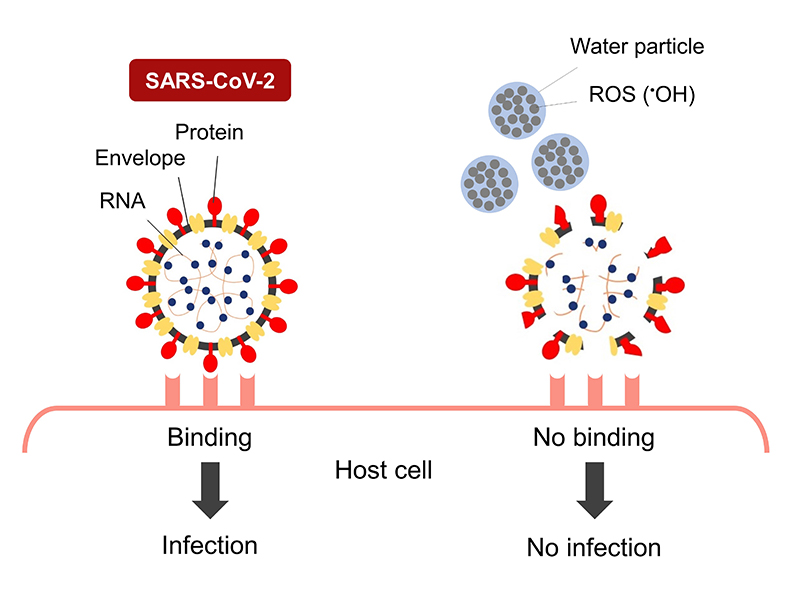Research News
Jun 17, 2022
Disinfectant mechanism of nano-sized electrostatic atomized water particles on SARS-CoV-2
Nano-sized electrostatic atomized water particles destroy SARS-CoV-2 envelope, protein, and RNA, thereby impairing the virus’s ability to bind to host cells
Current disinfection strategies have major drawbacks, which is why the World Health Organization does not advise routine spraying or fogging of biocidal agents, or UV light sterilization, in occupied areas. One possible alternative is nano-sized electrostatic atomized water particles generated by an electrospray device developed by Panasonic Corporation. The water particles contain reactive oxygen species (ROS) that damage lipid, protein, and DNA and are reported to disinfect several bacterial and viral species.
When the envelope, protein, and RNA of SARS-CoV-2 are damaged by nano-sized electrostatic atomized water particles, the virus is unable to bind to host cells.

In their previous research, Associate Professor Yasugi’s team showed that nano-sized electrostatic atomized water particles disinfect SARS-CoV-2, but the mechanism remained a mystery. Their new paper published in the Journal of Nanoparticle Research describes the damage they observed when SARS-CoV-2 was exposed to the nano-sized electrostatic atomized water particles.
The researchers showed the atomized water particles decreased the infectivity of SARS-CoV-2 to cells while observing the damage to the virus. “We observed that the nano-sized electrostatic atomized water particles damaged the viral envelope, protein, and RNA, making them unable to bind to host cells,” Associate Professor Yasugi explained. “The phenomena we observed are considered the main mechanism by which the nano-sized electrostatic atomized water particles disinfect SARS-CoV-2.We found that the target of the water particles is not the specific viral specific structure or specific proteins. Because the water particles impact viral envelope, protein, and RNA, they may disinfect other enveloped viral species as well.”
Funding
This study was funded by the Panasonic Corporation Living Appliances and Solutions Company.
Conflict of interest
This study was performed in collaboration with Panasonic Corporation Living Appliances and Solutions Company, and was financially supported by the company.
Paper Information
Title: Mechanisms underlying inactivation of SARS‑CoV‑2 by nano‑sized electrostatic atomized water particles
Journal: Journal of Nanoparticle Research
DOI: 10.1007/s11051-022-05485-5
Published: May 11, 2022
Journal of Nanoparticle Research (Springer Nature Website)
Contribution to SDGs

3: Good Health and Well-Being
Contact
Graduate School of Veterinary Science
Associate Prof. Mayo YASUGI
E-mail shishimaru[at]omu.ac.jp
*Please change [at] to @.
SDGs
